It took me good part of the day to make this cake, roughly 6-7 hours. No wonder nobody wants to do that these days. You could better spend your precious time watching your favorite TV show or a bunch of short YouTube specials. Or even better you could jump in the car, drive to nearby coffee shop and have a stale doughnut; a little dry but so what, it’s sweet and filling. Exactly! Who the hell has a day dedicated to make a cake when making food and eating supposed to be a very efficient operation. Make it fast, eat it even faster, move on. Flavors and textures are uniform and predictable wherever you go thanks to fast food franchise chains. Damn the diversification, we need a homogenized world without magic and mystery.
Do we??
Why would you care about this over 100 years old recipe that incidentally, was the most popular cake of one of Europe’s largest empires; the Austro-Hungarian empire. What did they know?
Really, well if you do think so, think again.
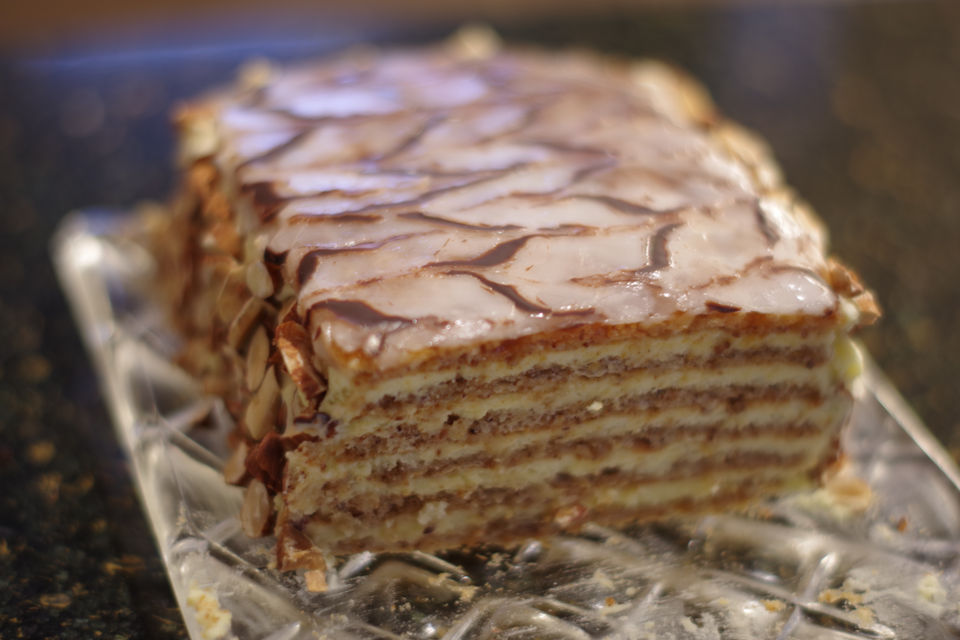
First this is the time and place where some of the greatest cakes ever, were made and the birthplace of tortes and rolls. This cake was devised by skilled Budapest confectioners and named after Hungarian nobility Prince Paul III Anton Esterházy, a diplomat of an empire. The longevity and popularity of this recipe is a testament to its quality. I would say this is plenty of reason to spark curiosity and to rise up as a challenge. Make something old and at the same time something new, brake the pervasive cliche of modern days and give a good food the attention it rightfully deserves.
The Esterházy Torte was a perfect choice for this year’s family day party and I can see why the recipe endured the test of time.
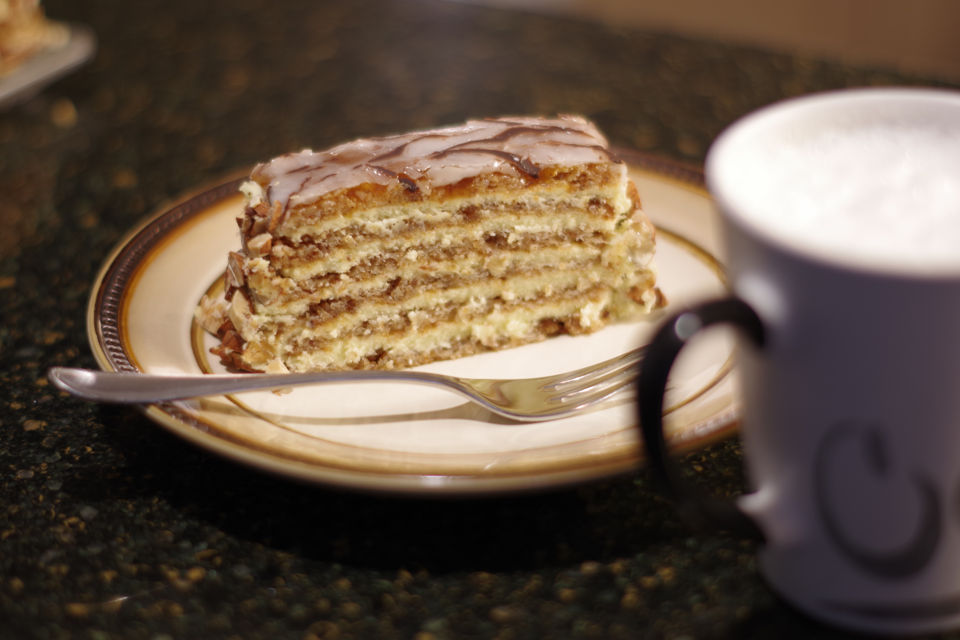
Family day is an official holiday in Ontario. Few years back, we decided that it’s a perfect excuse to get our broader family together for a dinner and a good time. In keeping with tradition, we did the same this year. To add to the joy I always make some good, traditional dessert and this year that was the Esterházy Torte. Before serving I always treat them with the story on the recipe background and what is special about it. They really seem to enjoy this part and I understand it. Tradition, historical and culinary insights add to the flair of the cake. Yes it did take some time to make but without any doubt, it was worth it and I would gladly do it again, any time. Everyone loved it and dessert plates were cleaned up in a quick succession.
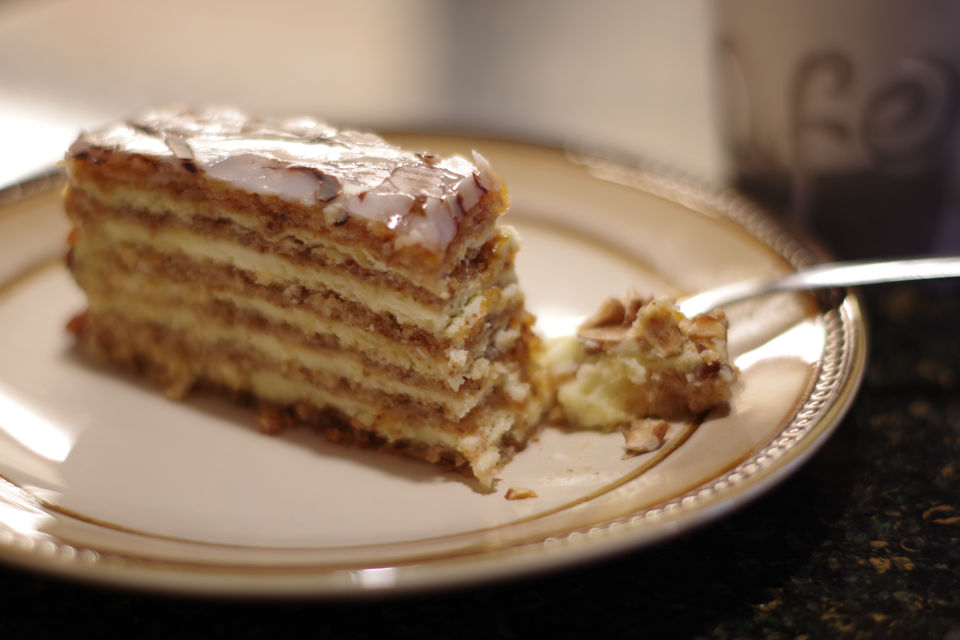
My take on the Esterházy Torte: The torte is gluten free and consists of six sponge layers made with a mixture of roasted hazelnuts and natural almonds. The top layer is glazed with an apricot glaze cooked in golden rum and then coated with Faux Fondant. The buttercream filling is complimented with a kirsch brandy which gives the cake a wonderful and sophisticated flavor. The cake sides are decorated with roasted almond slivers. It is a classic cake of a memorable taste.
The recipe is adapted from ” Kaffeehaus – Exquisite Desserts from the Classic Cafes of Vienna, Budapest and Prague“.
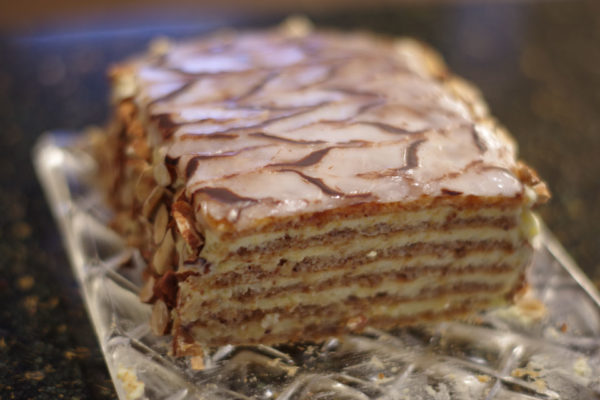
| Prep Time | 4-5 hours |
| Cook Time | 85 minutes |
| Passive Time | 30 |
| Servings |
slices
|
- 70 g roasted hazelnuts skin peeled; 1/2 cup equivalent
- 60 g natural almonds 1/2 cup equivalent
- 32 g confectioner's sugar 1/4 cup equivalent
- 5 egg whites large
- 100 g granulated sugar 1/2 cup equivalent
- 250 ml milk divided; 1 cup equivalent
- 2 tbsp cornstarch
- 134 g granulated sugar 2/3 cup equivalent
- 2 egg yolks large
- 227 g unsalted butter at room temperature, cut in small pieces; 1 cup equivalent
- 2 tbsp Kirsch can substitute with Cognac or golden rum
- 128 g confectioner's sugar sifted; 1 cup equivalent
- 1.66 tbsp water 1 tbsp + 2 tsp
- 2 tsp light corn syrup
- 60 ml apricot preserves 1/4 cup equivalent
- 1 1/4 tsp golden Rum
- 60 g sliced almonds toasted; 1/2 cup equivalent
- 30 g bittersweet chocolate melted; 1 ounce equivalent
Ingredients
Nut Layers
Kirsch Buttercream
Faux Fondant Icing
Apricot Glaze
Garnish
|

|
- Spread the hazelnuts over a baking pan and bake in the oven at 177°C (350°F) for about 25 minutes. Hazelnut skins will get very dark and cracked. Wrap the warm nuts in a kitchen towel and cool for 20 minutes. Rub the towel with nuts in a circling motion against the palm of your hand or a table top. This will remove almost all the skins and don't worry if some skin remains. This will add to the colour and flavor.
- Using a sharp knife, cut the almonds for garnish into slices, about 5-6 slices per almond. The easiest way do it is with the tip of the large kitchen knife resting on the cutting board and in a simple cutting motion downwards, use the back end of the blade to slice through. Spread the cut almond slices in one layer over the baking pan and bake in the oven at 177°C (350°F) for about 10 minutes. Let it cool.
- Position the rack in the center of the oven and preheat to 177°C (350°F).
- Lightly butter a 430 mm x 280 mm (17" x 11" ) baking pan. Line the bottom and the sides of the pan with parchment paper. Make a diagonal slice in each paper corner with a cut extending to the corner of the pan. This will allow to fold paper corners neatly. Trim the excess paper sticking above the pan sides.
- In a food processor grind the hazelnuts and almonds together with confectioners sugar until the nuts are very finely chopped.
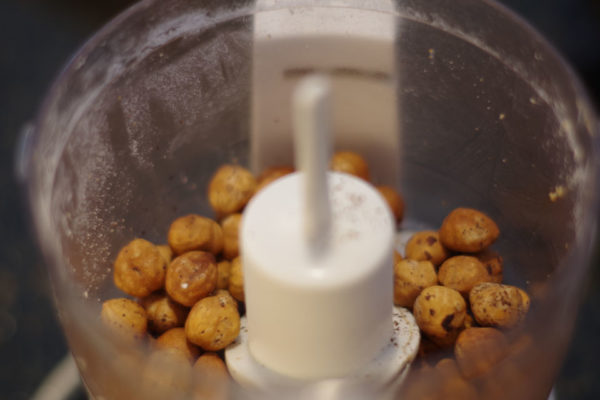
- In a large bowl, beat the egg whites until soft peaks form. Gradually add the granulated sugar and beat until stiff, shiny peaks form.
- Using silicone spatula, carefully fold in the processed nuts into the egg whites. Use a scooping motion from the outside towards the middle of the bowl. Make sure the nuts are loose and not clumped together before you add them to the egg whites. You want to minimize folding time to avoid deflating the egg whites.
- Use an offset metal spatula to spread the nut batter evenly into the pan.
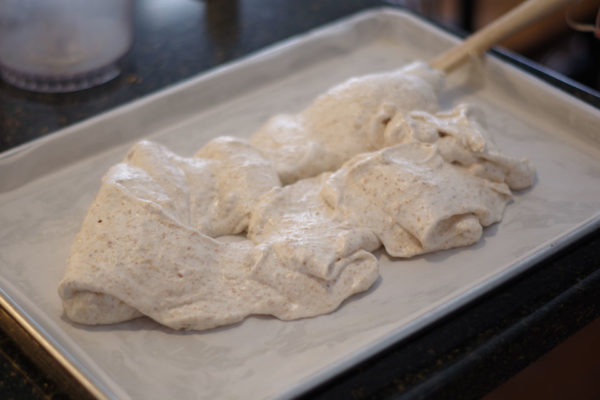
- Bake until golden brown, about 20 minutes.
- Use a knife to carefully separate the baked nut layer from the sides of the paper. Use another pan or a cutting board placed over the baking pan to invert together and un-mold the nut layer. Carefully peel away the parchment paper and let it cool completely.
- Using a serrated knife, trim the edges and cut the cake vertically into a six 70 mm (2 3/4") wide strips.
- Pour 60 ml (1/4 cup) of the milk into a medium size saucepan and add the cornstarch. Whisk to dissolve the cornstarch.
- Add the sugar and egg yolks and whisk until smooth.
- Whisk in the remainder of 190 ml (3/4 cup) of the milk.
- Over medium heat, whisking constantly and reaching the corners of the saucepan, bring to a full boil. The pastry cream will be thick and shiny.
- Remove from the heat and put the sauce pan in a bowl of ice water to cool the pastry cream. Stir constantly. When cooled set aside.
- In a medium bowl at high speed, beat the butter until smooth and fluffy.
- Beat in cooled pastry cream one tablespoon at a time.
- Beat in the kirsch.
- Select the best looking nut layer strip, smooth side up and place it on a wire rack. Set the wire rack over the baking pan.
- Add the apricot preserve and rum in a small saucepan. Bring it to a boil over medium heat, stirring constantly. Continue cooking for another 3-4 minutes until the glaze is very sticky. Strain the glaze through a wire sieve into a small bowl, pressing hard on solids using the back of the spoon. Using an offset spatula, spread the warm glaze evenly over the nut layer. Let the glaze set for about 15 minutes.
- Melt the chocolate in a double boiler. Prepare a small parchment paper cone for piping.
- Add confectioner's sugar, water and light corn syrup to another small saucepan and stir until smooth. Over very low heat, stirring constantly, warm up the glaze to the temperature of 33° to 35°C (92° to 95°F). If temperature rises above 35°C (95°F) you will have to do it all over again. Quickly pour the warm fondant icing over the glazed nut layer. Smooth it over evenly with offset metal spatula. Let the excess drip over the sides.
- Immediately pipe four thin straight parallel lines of chocolate, approximately 20 mm (3/4") apart along the entire length of fondant coated nut layer.
- Using a wooden toothpick, draw straight parallel lines from right to left, 25 mm (1") apart, across the chocolate lines. Then working in opposite direction, left to right, draw the lines in between first set of lines. This will create a feathered effect. Make sure you wipe off the toothpick with a towel after each line.
- Let stand until the glaze is set. Use a thin, sharp knife to run under the glazed nut layer and separate it from the rack. This will be the top or the last nut layer placed on the cake.
- Place the first nut layer on a rectangular serving plate, securing it with a dab of buttercream.
- Using an offset metal spatula, spread evenly approximately 3 tablespoons of buttercream.
- Repeat the process with the remaining 4 nut layers ending with the buttercream. Use the remaining buttercream to spread a thin layer around all four sides of the cake.
- Place the glazed and decorated nut layer on top. Press the toasted almond slices onto the sides of the cake.
- Refrigerate until buttercream is firm and chilled, best if left overnight. To serve, use a thin sharp knife to cut crosswise into 8 slices.

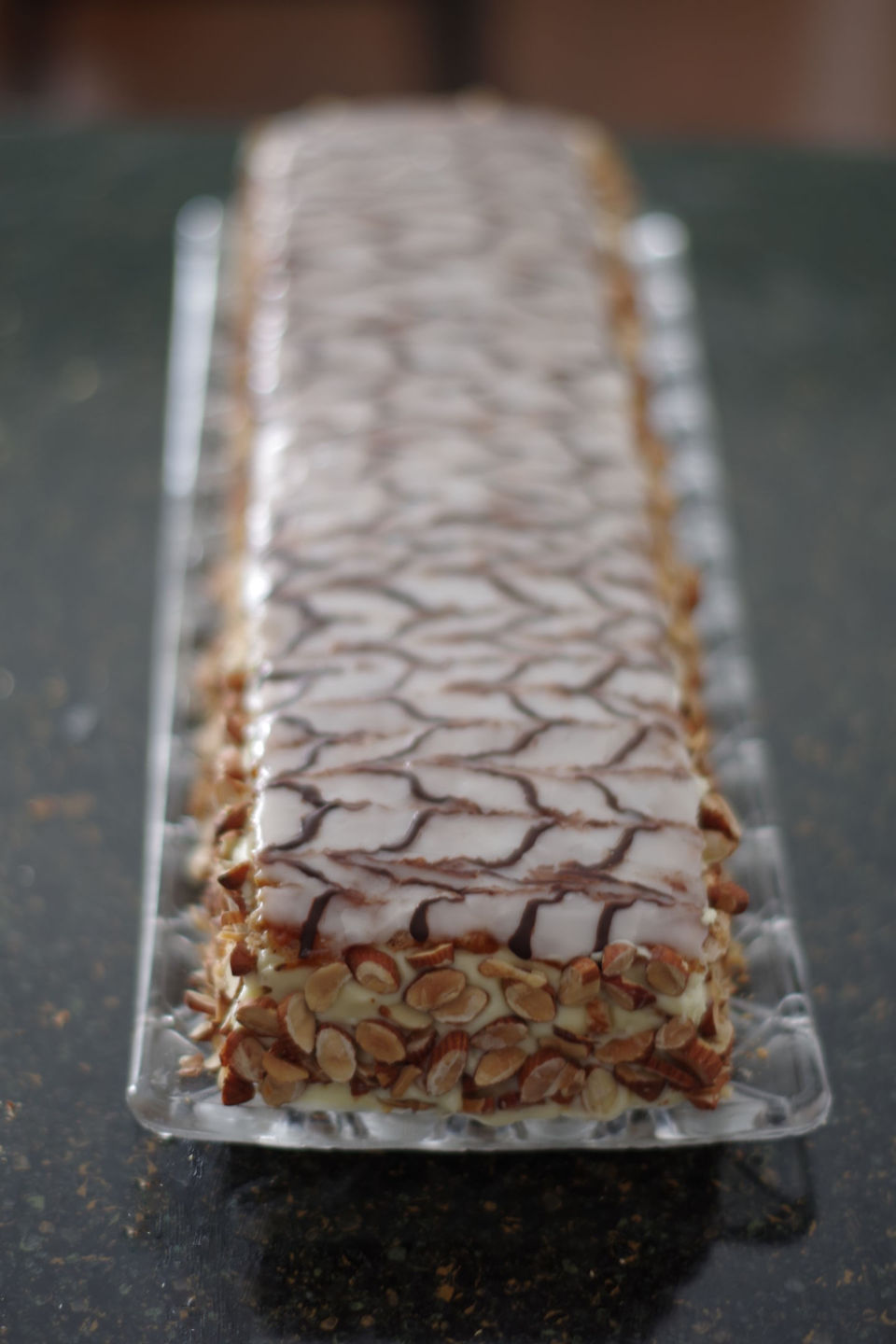
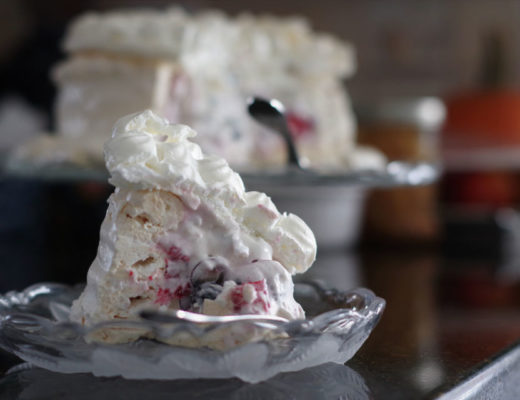
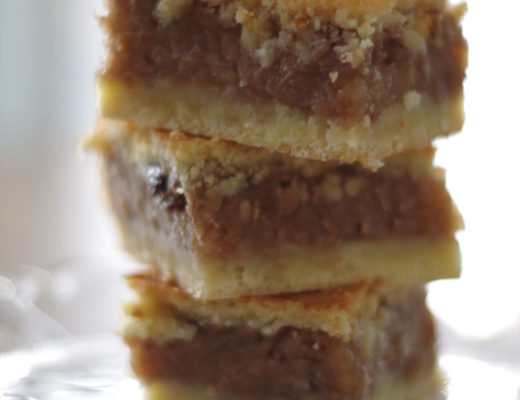
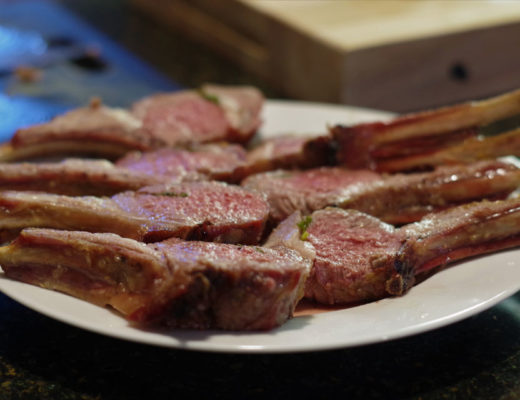
6 Comments
Sam
March 5, 2021 at 7:04 pmCould I replace with 100% walnuts?
Gordan
March 5, 2021 at 7:36 pmYes you can, but then that will be a different torte with a different flavor profile. If you want Esterházy Torte you have to stick with the prescribed recipe ingredients. Happy baking!
natalya alexander
August 22, 2020 at 9:18 pmThe recipe does not say how many egg whites are used for the nut layers. Would you please fix it.
Gordan
August 22, 2020 at 11:13 pmHi Natalya, I added missing information to the recipe, my apologies for the error. Thanks for stopping by and checking in on my blog! Let me know if you have any other questions?
Catherine Faulkner
June 13, 2020 at 1:26 pmLovely looking cake.. I am looking for a reciepe for a cake my hungarian man used to make and we always called it 6 slice. I can make but was looking for a reciepe other than one my nan made me learn by heart as she refused to write it! Any suggestions? 6 layers of really thin biscuit, layered with a chocolate caramel sauce and topped with meringue type icing….
Gordan
June 18, 2020 at 10:36 pmIt is difficult to go just by the number of layers, the number of layers is easily changed. I am going to speculate it could be a modified version of a most famous Hungarian cake, Dobos Torte. Dobos Torte normally has 6 layers and is filled with chocolate buttercream. Hopefully this helps, good luck in your search!